A Gun Girl’s 5 Rules for Conceal Carry
OutdoorHub Reporters 02.28.18

I wasn’t always a gun girl. As a matter of fact, only 6 years ago, my knowledge of firearms was limited to what little I’d learned about the hunting shotguns our family used during my childhood.
Once I started traveling often and alone, however, I decided to buy my first handgun simply for protection. Still, I had acquired very little knowledge except the basic shooting skills and cleaning.
When I first took a job at a local gun shop, I was a bit overwhelmed. There seemed to be so much to learn about so many things. After a few years of working in the gun industry, I’m still far from an expert. But I have had the opportunity to help many women purchase their first firearm, and assist them on the best way to carry it concealed.

If you’re looking to purchase your first handgun, are a beginner shooter, or looking to get your conceal carry license, then here are five things to keep in mind.
1. Function over fashion — for both handguns AND holsters. Many new women shooters are drawn to the handgun that looks the nicest. But, until you pick it up, shoot it, and then compare it to a few other guns, you aren’t going to know which one works best for you.
The No. 1 piece of advice I could give anyone, man or woman, looking to purchase a firearm is to shoot, shoot, shoot. Go to your local gun shop and rent some handguns. Try different brands, different models, different calibers. A carry handgun is a purchase that isn’t only intended to last a lifetime, but also a purchase intended to protect your life. You need to choose the gun and holster combo that is best for YOU. It doesn’t matter what is best for the salesman or your husband or best friend — choosing a carry gun is a completely personal choice.
2. Size matters. The biggest struggle many women come across when carrying concealed is being able to actually conceal. I’m on the thinner side, so I felt my options were limited when it came to the size of the firearm. I started out carrying the M&P Shield in a 40 caliber, and recently downsized to a Bodyguard 380 because it’s smaller.
A large-frame handgun is often more comfortable to shoot and will most likely feel better in your hand. But when shopping for a concealable weapon, keep size in mind. The more you practice and train with your gun — no matter whether it is a compact, subcompact or full size — the more comfortable you will feel carrying it.
Try to stay open-minded to a variety of calibers. With the stopping power that comes with today’s self-defense ammo, even smaller calibers can get the job done. (I recommend staying in a caliber higher than a .22). If you struggle with a semiautomatic pistol, then consider the simplicity of a revolver.
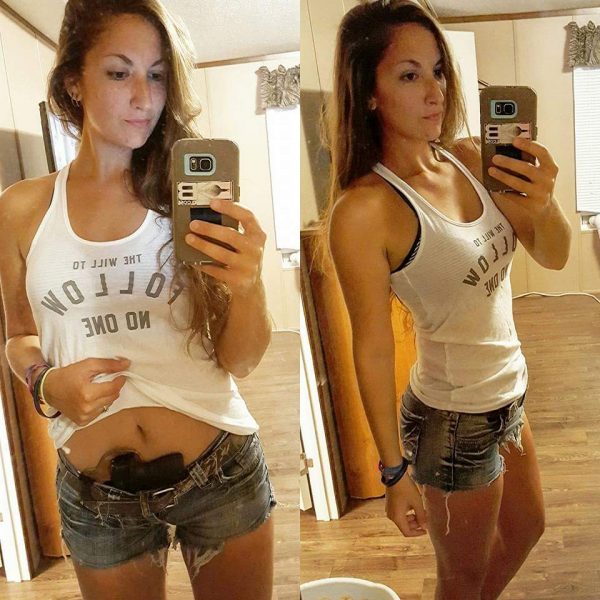
3. All day, every day — wear it. That’s how you will find the holster that is right for you. Quite honestly, I was a bit lost when I first started shopping for holsters. I didn’t really know any other women who carried on a regular basis. To help shorten your search, I’ll discuss the basic carry systems available to women. As you’ll see, I like some of them much more than others.
Open: I only open carry when I’m hiking in the woods, occasionally while hunting, or working in the woods or on the farm. Open carrying in public, although perfectly legal in many states, can lead to unwanted attention and confrontation.

Purse/bag carry: This is something I rarely do. I have always felt most comfortable carrying on my person because I know where my firearm is at all times; I have full control over it. There is no risk of losing it or someone grabbing it when properly concealed. Is carrying your handgun in your purse wrong? Certainly not. There are various purses specifically made to carry your firearm, and it is always better to have a gun in your purse than no gun at all. Many times, I carry my handgun in a backpack when out fishing in the summer, simply because it’s hot and sweaty out. When looking for a conceal carry bag or purse, I highly recommend one with straps that go across your body to keep it close at all times. You can find some great selections at The Well Armed Woman.
Appendix carry: This is my go-to carry position. I carry at a slight crossdraw so the holster fits snugly in the dip off my hip bone and is easily concealable. My biggest issue here was finding a holster that stayed in place, and rode at an appropriate height so as not to interfere when I was sitting or driving. The Crossbreed inside-the-waistband Appendix Carry holster is one of my favorites, along with the MiniTuck. I’ve stayed away from soft nylon holsters as I’ve seen some instances where the material gets caught up in the trigger card and could cause an accidental fire.
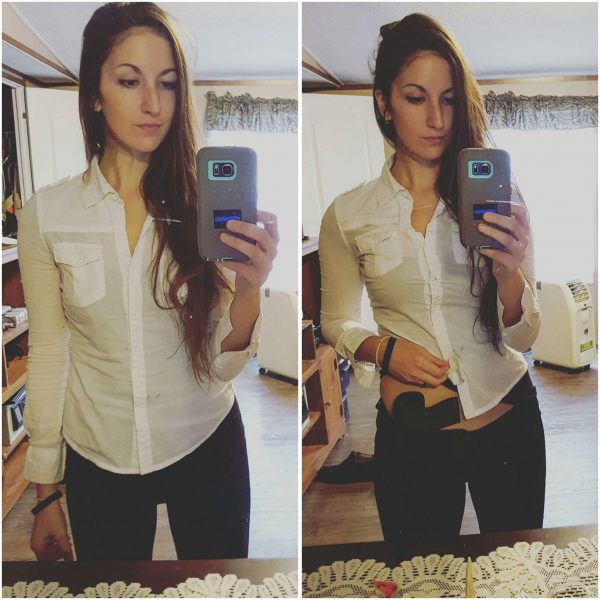
Hip/kidney carry: I occasionally like to switch up my carry position to my hip or kidney. I’m still getting used to these because I always feel more comfortable carrying my firearm in front of me. (It feels so much easier to reach!) Due to the natural curves of a woman’s body, carrying “small of your back” is also easy. However, I’ve always worried that someone could catch a glimpse of it from behind me and be able to grab my handgun before I had warning.
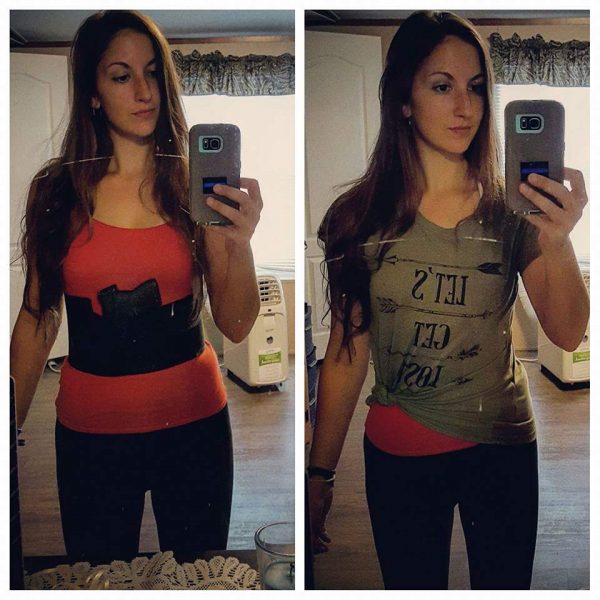
Belly band: For a short period of time, I worked in a warehouse, constantly moving, lifting and bending over to pick things up. Although the company didn’t have a firearms policy, I was worried that someone might see my firearm and report me. For that reason, I retired my Crossbreed appendix holster for a short time and tried the belly band holster. Belly bands are self-explanatory — they’re to be worn around your belly — and made of a durable elastic with heavy-duty Velcro for adjustments. Mine could hold one firearm and an extra magazine. I did find I needed to wear a tank top underneath the belly band to prevent chafing, but it was extremely comfortable and concealed very well. I had purchased the smallest I could find, and because it was a bit big, I wore it over my rib cage, and this actually seemed to work to my advantage for concealment.
Corset: Although I haven’t purchased one yet, I have heard amazing things about this conceal method (photo below). This is next on my list of holsters to purchase. You can find a variety on the Dene Adams site.
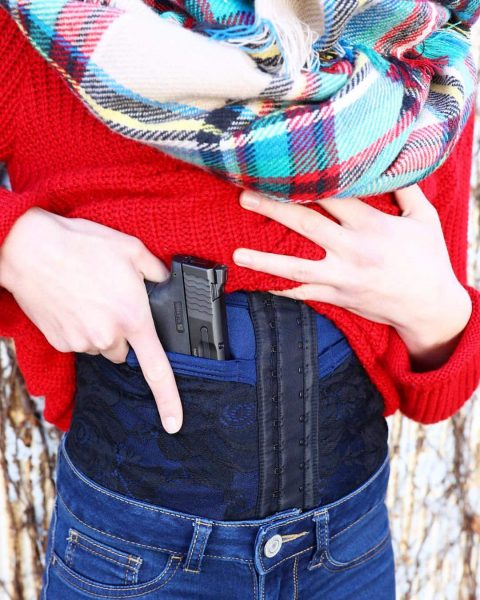
4. Dress for success. Once I started carrying, I made some slight adjustments to my wardrobe and how I dressed. If I was going to conceal properly, I would need to dress accordingly. Flowy tank tops became my go-to summer outfit. And I purchased a few good, sturdy belts and wore them frequently.
5. Train how you carry. Of course, you’re going to want to become as comfortable as possible with both shooting and carrying your handgun. But what some people forget is it’s also important to practice drawing your firearm and shooting it from the holster, no matter how you choose to carry. If you needed to draw your weapon in the face of danger, you don’t want to be fumbling around trying to get it out of the holster.
Most indoor ranges don’t allow you to draw from any sort of concealed holster, which is understandable. If you own property with a few acres of woods or fields, you can practice outdoors using safety precautions. One of the easiest and safest ways to practice drawing from your holster is to practice with an unloaded gun. It is extremely crucial to ensure your gun is unloaded, and even then it is best to ensure others aren’t around. An empty basement is an ideal place to train. Practice. Practice often. Period.
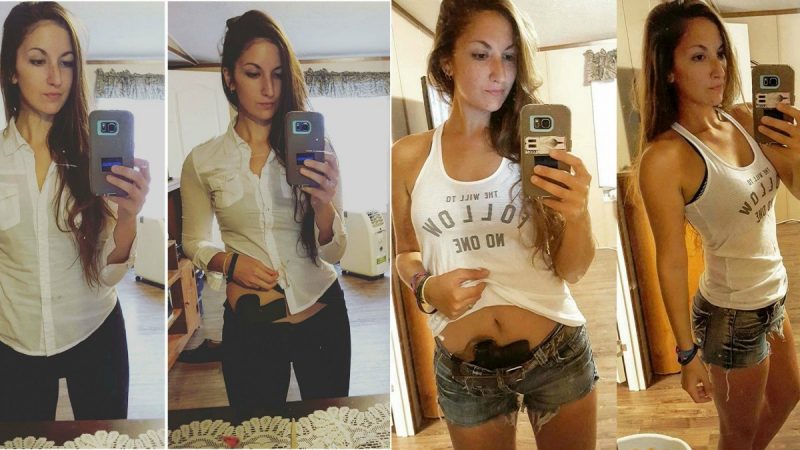
I’ll end this article with a quote from Greg Gutfeld at Fox News because it sums up my thoughts on conceal carry perfectly: “A Smith and Wesson does more for empowering women than feminism ever could.”

